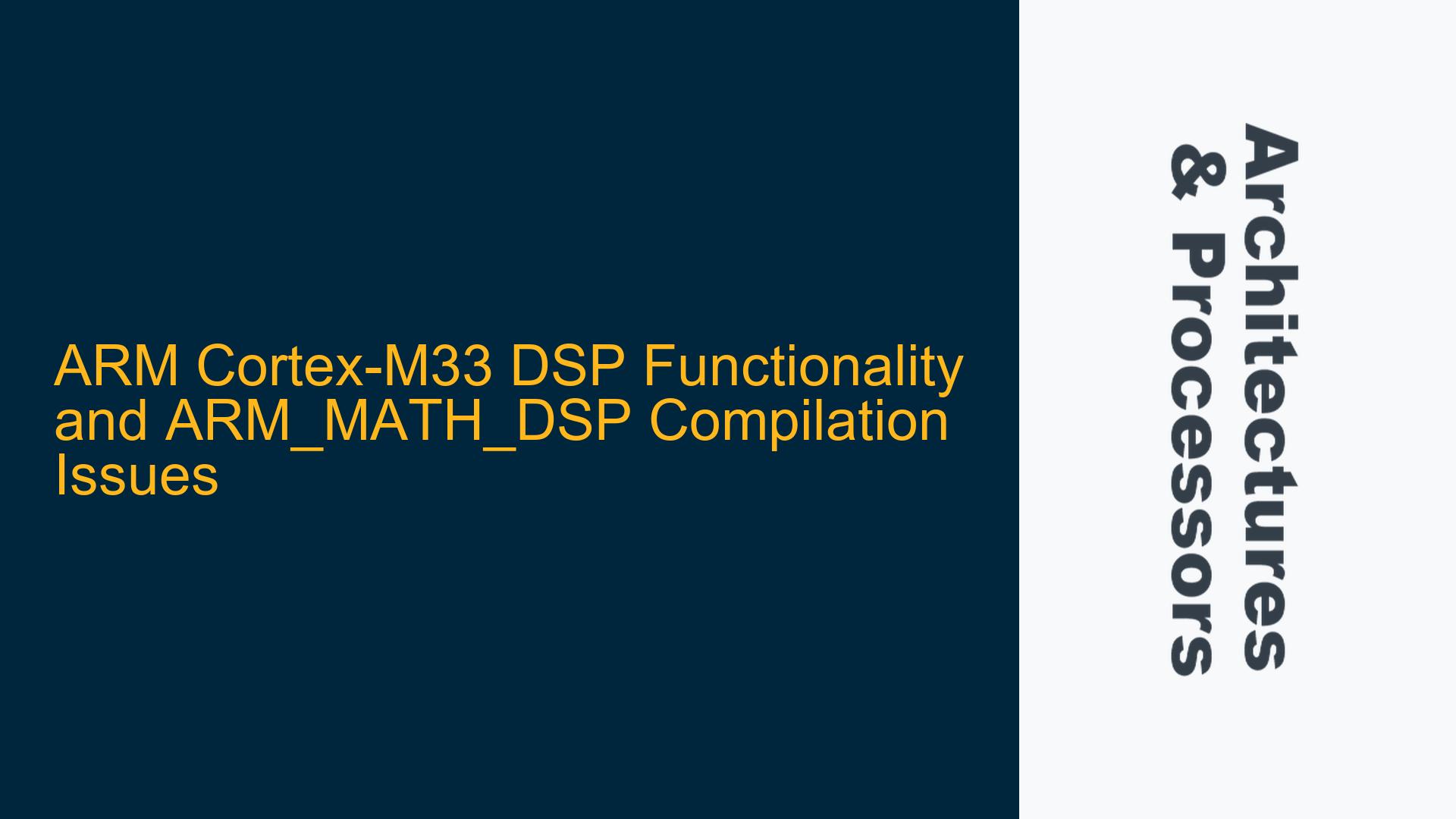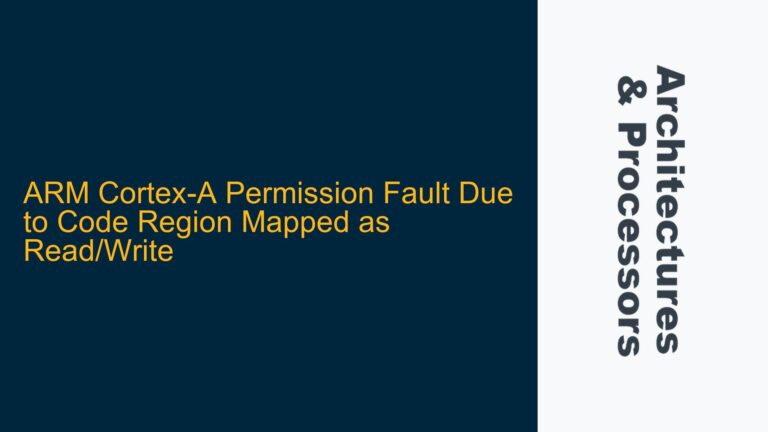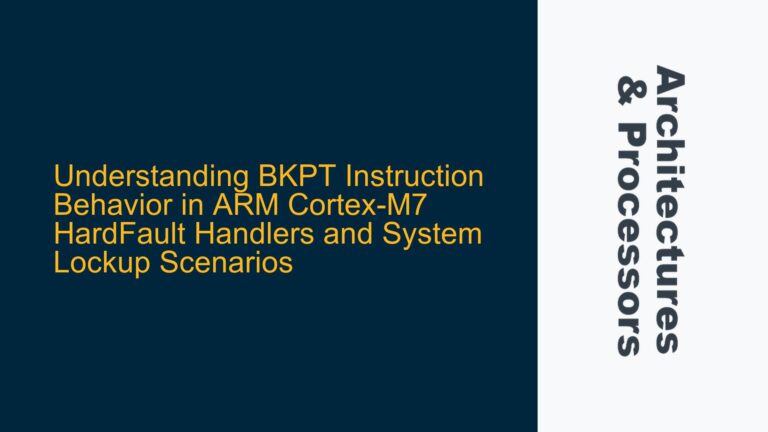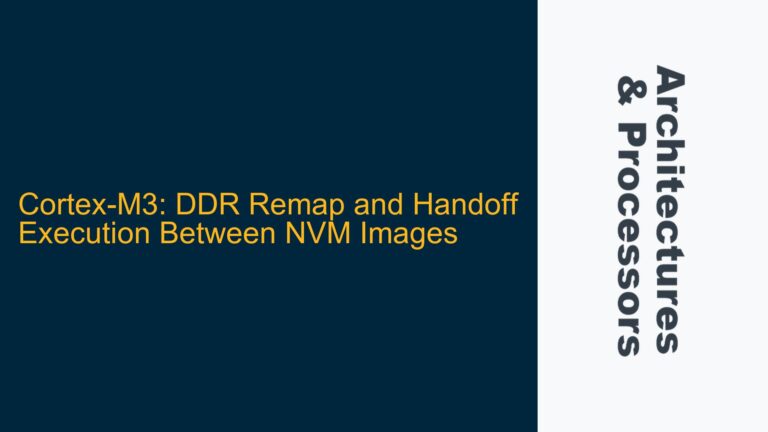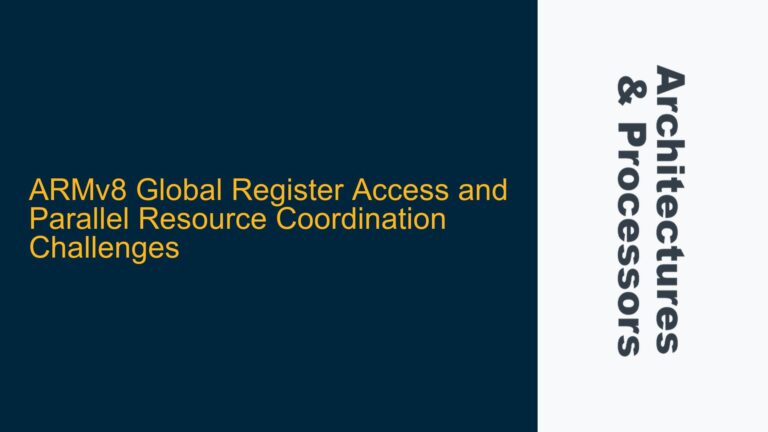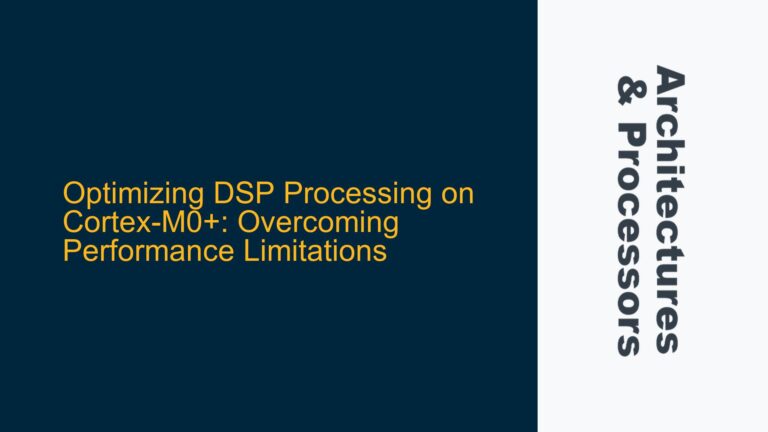ARM Cortex-M33 DSP Capabilities and ARM_MATH_DSP Compilation Flags
The ARM Cortex-M33 processor, part of the ARMv8-M architecture, integrates a Digital Signal Processing (DSP) extension, which provides enhanced capabilities for signal processing tasks. These capabilities include single-cycle multiply-accumulate (MAC) operations, saturating arithmetic, and SIMD (Single Instruction, Multiple Data) instructions. The CMSIS-DSP library, a suite of common signal processing functions optimized for ARM Cortex-M processors, leverages these DSP extensions to deliver high-performance signal processing.
However, a critical issue arises when using the CMSIS-DSP library with the ARM Cortex-M33 processor. The ARM_MATH_DSP macro, which enables DSP-specific optimizations in the CMSIS-DSP library, is traditionally defined based on the target architecture being ARMv7E-M (ARM Cortex-M4/M7). This raises the question of whether the DSP-specific functions in the CMSIS-DSP library are utilized when targeting the ARM Cortex-M33, which is based on the ARMv8-M architecture.
The ARM_MATH_DSP macro is crucial because it activates optimized code paths that take advantage of the DSP extensions present in the ARM Cortex-M4/M7 processors. If this macro is not defined for the ARM Cortex-M33, the library may fall back to generic, non-optimized implementations, potentially leading to suboptimal performance for DSP tasks.
Compilation Flag Mismatch and DSP Functionality Discrepancies
The core of the issue lies in the compilation flags and how the ARM_MATH_DSP macro is derived. The ARM_MATH_DSP macro is typically set based on the target architecture specified during compilation. For ARM Cortex-M4/M7 processors, the target architecture is ARMv7E-M, which automatically triggers the definition of ARM_MATH_DSP. However, for the ARM Cortex-M33, the target architecture is ARMv8-M, which does not inherently define ARM_MATH_DSP.
This discrepancy can lead to a situation where the DSP-specific optimizations in the CMSIS-DSP library are not activated for the ARM Cortex-M33, even though the processor includes DSP extensions. The result is that the library may not fully utilize the hardware capabilities of the ARM Cortex-M33, leading to inefficient execution of DSP tasks.
The issue is further complicated by the fact that the ARM Cortex-M33’s DSP extensions are not identical to those in the ARM Cortex-M4/M7. While there is significant overlap, there are also differences that may require specific optimizations. For example, the ARM Cortex-M33 introduces new instructions and enhancements that are not present in the ARM Cortex-M4/M7, such as the ARMv8-M Main Extension instructions. These new instructions could potentially be leveraged to further optimize DSP tasks, but only if the CMSIS-DSP library is aware of them.
Enabling ARM_MATH_DSP for ARM Cortex-M33 and Optimizing DSP Performance
To ensure that the ARM Cortex-M33 fully utilizes its DSP capabilities when using the CMSIS-DSP library, it is necessary to explicitly define the ARM_MATH_DSP macro during compilation. This can be done by modifying the compilation flags to include the definition of ARM_MATH_DSP, even though the target architecture is ARMv8-M.
For example, when using the ARM GCC compiler, the following flag can be added to the compilation command:
-DARM_MATH_DSP
This ensures that the ARM_MATH_DSP macro is defined, enabling the DSP-specific optimizations in the CMSIS-DSP library. Additionally, it is important to verify that the library is correctly configured to recognize the ARM Cortex-M33’s DSP extensions. This may involve checking the library’s configuration files and ensuring that the appropriate preprocessor definitions are in place.
Once the ARM_MATH_DSP macro is defined, the next step is to verify that the DSP-specific functions in the CMSIS-DSP library are being utilized. This can be done by examining the generated assembly code or by profiling the application to ensure that the expected performance improvements are achieved.
In some cases, it may be necessary to modify the CMSIS-DSP library to fully leverage the ARM Cortex-M33’s DSP extensions. This could involve adding new optimized functions that take advantage of the ARMv8-M Main Extension instructions or modifying existing functions to better align with the ARM Cortex-M33’s architecture.
Finally, it is important to thoroughly test the application to ensure that the DSP optimizations are functioning correctly and that there are no unintended side effects. This includes testing for functional correctness, performance improvements, and any potential impacts on power consumption or memory usage.
In conclusion, while the ARM Cortex-M33 processor includes DSP extensions that can significantly enhance signal processing tasks, ensuring that these capabilities are fully utilized requires careful attention to compilation flags and library configuration. By explicitly defining the ARM_MATH_DSP macro and verifying that the CMSIS-DSP library is correctly optimized for the ARM Cortex-M33, developers can unlock the full potential of the processor’s DSP capabilities.
Detailed Analysis of ARM Cortex-M33 DSP Extensions and CMSIS-DSP Integration
The ARM Cortex-M33 processor’s DSP extensions are designed to accelerate a wide range of signal processing tasks, including filtering, Fourier transforms, and matrix operations. These extensions are built on the foundation of the ARMv7E-M architecture but include additional enhancements specific to the ARMv8-M architecture.
One of the key features of the ARM Cortex-M33’s DSP extensions is the support for single-cycle MAC operations. These operations are essential for many DSP algorithms, such as finite impulse response (FIR) filters and fast Fourier transforms (FFTs). The ARM Cortex-M33 also supports saturating arithmetic, which is crucial for preventing overflow and underflow in fixed-point DSP calculations.
In addition to these features, the ARM Cortex-M33 introduces new instructions as part of the ARMv8-M Main Extension. These instructions include enhanced SIMD operations, which allow multiple data elements to be processed in parallel within a single instruction. This can lead to significant performance improvements for tasks such as vector addition, subtraction, and multiplication.
The CMSIS-DSP library is designed to take advantage of these DSP extensions by providing optimized implementations of common signal processing functions. However, as previously discussed, the library’s optimizations are typically tied to the ARM_MATH_DSP macro, which is not automatically defined for the ARM Cortex-M33.
To fully integrate the ARM Cortex-M33’s DSP extensions with the CMSIS-DSP library, it is necessary to ensure that the library is aware of the processor’s capabilities. This involves not only defining the ARM_MATH_DSP macro but also ensuring that the library’s configuration files are correctly set up to recognize the ARM Cortex-M33’s architecture.
One approach to achieving this integration is to modify the library’s header files to include specific optimizations for the ARM Cortex-M33. For example, the library’s configuration files could be updated to include conditional compilation directives that enable ARM Cortex-M33-specific optimizations when the target architecture is ARMv8-M.
Another approach is to create a custom build of the CMSIS-DSP library that includes additional optimizations for the ARM Cortex-M33. This could involve adding new functions that leverage the ARMv8-M Main Extension instructions or modifying existing functions to better align with the ARM Cortex-M33’s architecture.
In either case, it is important to thoroughly test the modified library to ensure that the optimizations are functioning correctly and that there are no unintended side effects. This includes testing for functional correctness, performance improvements, and any potential impacts on power consumption or memory usage.
Practical Steps for Enabling DSP Optimizations on ARM Cortex-M33
To enable DSP optimizations on the ARM Cortex-M33 using the CMSIS-DSP library, follow these practical steps:
-
Define the ARM_MATH_DSP Macro: Ensure that the ARM_MATH_DSP macro is defined during compilation. This can be done by adding the appropriate flag to the compilation command, such as
-DARM_MATH_DSPfor the ARM GCC compiler. -
Verify Library Configuration: Check the CMSIS-DSP library’s configuration files to ensure that they are correctly set up to recognize the ARM Cortex-M33’s architecture. This may involve modifying the library’s header files to include conditional compilation directives for the ARM Cortex-M33.
-
Examine Generated Assembly Code: After compiling the application, examine the generated assembly code to verify that the DSP-specific optimizations are being utilized. Look for instructions that indicate the use of the ARM Cortex-M33’s DSP extensions, such as single-cycle MAC operations and SIMD instructions.
-
Profile the Application: Use profiling tools to measure the performance of the application and ensure that the expected performance improvements are achieved. Compare the performance with and without the ARM_MATH_DSP macro defined to quantify the impact of the DSP optimizations.
-
Test for Functional Correctness: Thoroughly test the application to ensure that the DSP optimizations are functioning correctly and that there are no unintended side effects. This includes testing for functional correctness, performance improvements, and any potential impacts on power consumption or memory usage.
-
Consider Custom Optimizations: If necessary, consider creating a custom build of the CMSIS-DSP library that includes additional optimizations for the ARM Cortex-M33. This could involve adding new functions that leverage the ARMv8-M Main Extension instructions or modifying existing functions to better align with the ARM Cortex-M33’s architecture.
By following these steps, developers can ensure that the ARM Cortex-M33’s DSP capabilities are fully utilized when using the CMSIS-DSP library, leading to improved performance and efficiency for signal processing tasks.
Conclusion
The ARM Cortex-M33 processor’s DSP extensions offer significant potential for accelerating signal processing tasks, but realizing this potential requires careful attention to compilation flags and library configuration. By explicitly defining the ARM_MATH_DSP macro and ensuring that the CMSIS-DSP library is correctly optimized for the ARM Cortex-M33, developers can unlock the full capabilities of the processor’s DSP extensions. This involves not only enabling the DSP-specific optimizations in the library but also verifying that these optimizations are functioning correctly and delivering the expected performance improvements. With the right approach, the ARM Cortex-M33 can serve as a powerful platform for high-performance signal processing applications.
